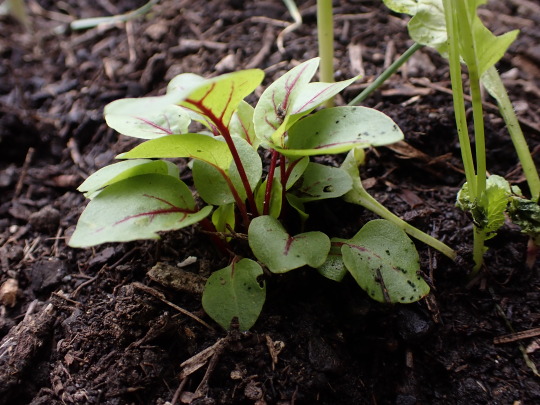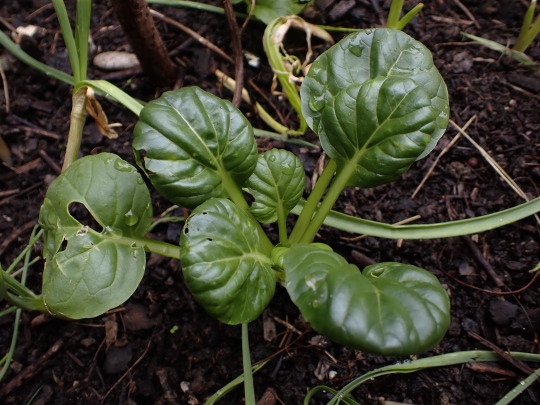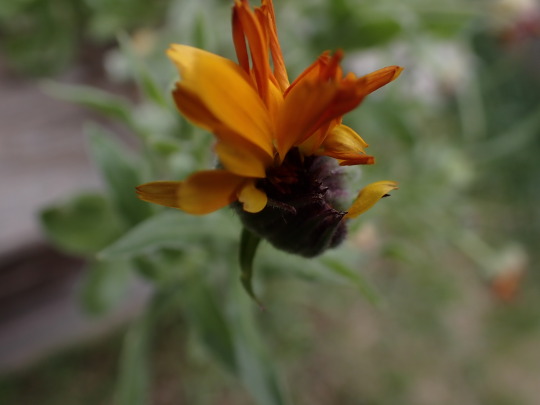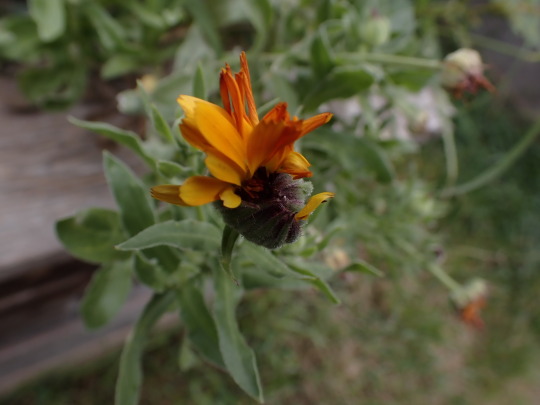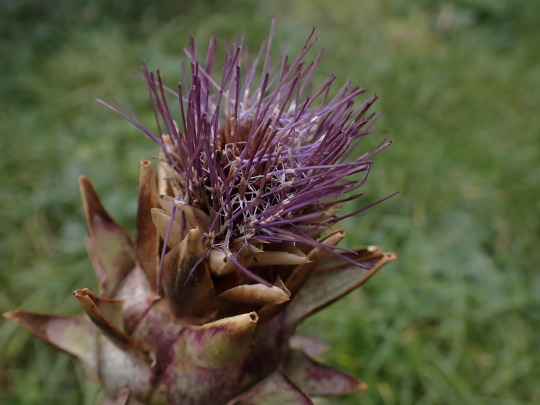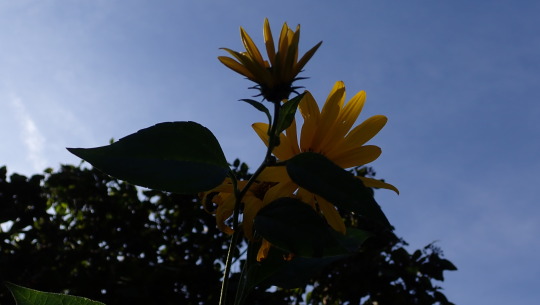#Ringelblume
Explore tagged Tumblr posts
Text

19 notes
·
View notes
Text




Ringelblumen | Common / Garden marigold, ruddles, shining herb
Calendula officinalis
10 notes
·
View notes
Text
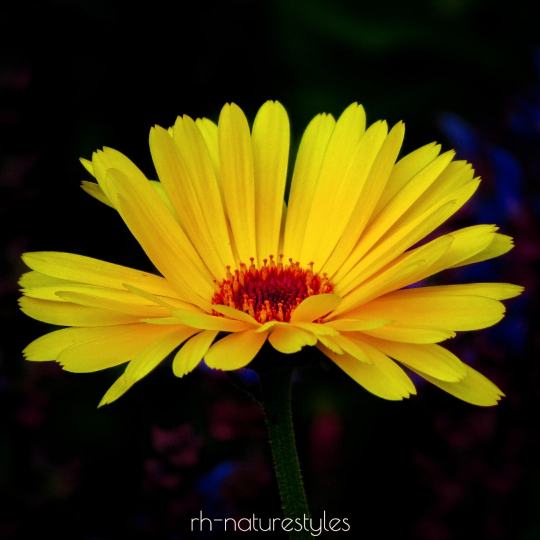
gelbe Ringelblume 🌸🌱✨ @rh-naturestyles
#ringelblume#coneflowers#coneflower#ringelblumen#blumenwiese#bloom#nature#flower#garden#blossom#blumen#fleur#flores#blooms
6 notes
·
View notes
Text

6.1.2025: Die Hoffnung ist erfroren
#phototagebuch#tagesphoto#photo diary#photo of the day#photojournal#photo du jour#photo des tages#vienna#wien#urban nature#zaubergarten#6.1.2025#frost#ringelblume#calendula#ari fink photography
0 notes
Text
Die heilenden Eigenschaften von Ringelblume bei Hautentzündungen
Die heilenden Eigenschaften von Ringelblume bei Hautentzündungen Hast du schon einmal von der Ringelblume gehört? Nein, ich rede nicht von dem hübschen kleinen Blümchen, das in deinem Garten wächst und sich mit den anderen Pflanzen um die Wette sonnt. Ich spreche von der Ringelblume, die nicht nur gut aussieht, sondern auch ein wahres Wundermittel für deine Haut ist. Wenn du dich jetzt fragst,…
#ätherische Öle#Bindung#Ernährung#Generationen#Hautpflege#Heilpflanzen#Heilung#Jojobaöl#Kinder#Lebensstil#Lernen#Nährstoffe#Regeneration#Ringelblume#Rückzug
0 notes
Text










3. Oktober 2023
#3.10.2023#urban garden#cardy#schmelzgarten#ringelblume#rosmarin#tatsoi#pak choi#rosetten pak choi#blut-ampfer#fetthenne
0 notes
Text
Sandras Pflanzenwelt: Ringelblume (Calendula officinalis)
Ringelblume ist eine vielseitige Blume. Sie hat einen hohen Zierwert, ihre Blüte eignen sich zum Verzehr und sie wird in der Heilkunde eingesetzt. Ihre Blüte fällt sofort auf und sie harmoniert mit einer Vielzahl anderer Pflanzen. Ich habe sie in dieser Gartensaison, dass erstmal vorgezogen und in unser Rosenbeet gepflanzt. Das blumige Ergebnis finde ich sehr gelungen und bildet zu den…

View On WordPress
#Anpassungsfähig#Beetgestaltung#Einjährige Sommerblume#Essbare Blüten#Heilpflanze#hoher Zierwert#Insektenfreundlich#offene Blüte#Pflegeleicht#Ringelblume
0 notes
Video
n289_w1150 by Biodiversity Heritage Library Via Flickr: J. Sturms Flora von Deutschland : Stuttgart :K. G. Lutz,1900-1907. biodiversitylibrary.org/page/55506527
#Germany#Royal Botanic Gardens Kew#Library#Art & Archives#bhl:page=55506527#dc:identifier=https://biodiversitylibrary.org/page/55506527#flowers#Calendula officinalis#Calendula#Echte Ringelblume#pot marigold#mary's gold#scotch marigold#ruddles#flickr
6 notes
·
View notes
Text
The story of the Oyneg Shabes archive. Between 1940 and 1943 a group of dedicated writers, led by historian Emanuel Ringeblum, secretly recorded daily Jewish existence in the Warsaw Ghetto. It would become history as survival. Anton Lesser narrates this new 10-part series revealing the lives, stories and destruction of the Ghetto.
With Elliot Levey, Alfred Molina, Tracy-Ann Oberman, Karl Prekopp and Simon Russell Beale (in episode 8)
All ten episodes are available here
More about the Ringelblum Archive
#Simon Russell Beale#Warsaw Ghetto#radio#Anton Lesser#Alfred Molina#Elliot Levey#Tracy-Ann Oberman#bbc radio 4#Oyneg Shabes archive#Emanuel Ringelblum#Wladyslaw Szlengel#2023
7 notes
·
View notes
Text
Carolina Ringelblume

Former shopkeeper, and the current cafeteria lady in RFA.
Being the offspring of the half-fairy and beastman, Carolina is powerful enough to defend the evils and chaotic.
Her magic is ice based. It linked to her emotions in despair and anger, except for happy. Also she can speak to birds.
Although as the half-fairy and beastman, Carolina can't transform into the fox form.
She is kind and generous to every customers.
In her youth, Carolina was kept away from the outside world, thanks to the lies of her adoptive mother, she is somewhat naive, insecure, and a bit fearful of the world, but can be determined.
She was used to be a student to the other magic school with her best friend. That is after she was found by a fairy, while her adoptive mother was sent to the jail.
For the first time in study at the school, Carolina was turning in a straightforward individual with a troublemaker behavior.
After graduated in the college, Coralina becomes a shopkeeper at RFA for takes a small business.
She worked in her shop for 7 years before Callum showed up at the school. Later she moved to become a canteen lady when Callum opens his magic store.
Her last name Ringelblume is the German word of "marigold", probably refer to her hair color.
Like Annabelle, Carolina's face looks exactly like a 3 year old girl, while her height is shorter among Annabelle and Aurora.
She extremely loves strawberry treats and desserts, though she carries a half of beastman's blood.
4 notes
·
View notes
Text
i have this excerpt from Notes from the Warsaw Ghetto: The Journal of Emmanuel Ringelblum printed and framed
Like, I paid an etsy seller to print it for me on the nicest cardstock with the best ink, and then I waited in line and paid a stupid amount of money to have it framed at the Michael's custom framing counter. And I have zero regrets. I've probably posted this excerpt here before but I don't care. It is everything.
The heroic girls, Chajke and Frumke—they are a theme that calls for the pen of a great writer. Boldly they travel back and forth through the cities and towns of Poland. They carry “Aryan” papers identifying them as Poles or Ukrainians. One of them even wears a cross, which she never parts with except when in the Ghetto. They are in mortal danger every day. They rely entirely on their “Aryan” faces and on the peasant kerchiefs that cover their heads. Without a murmur, without a second’s hesitation, they accept and carry out the most dangerous missions. Is someone needed to travel to Vilna, Bialystok, Lemberg, Kowel, Lublin, Czestochowa, or Radom to smuggle in contraband such as illegal publications, goods, money? The girls volunteer as though it were the most natural thing in the world. Are there comrades who have to be rescued from Vilna, Lublin, or some other city?— They undertake the mission. Nothing stands in their way, nothing deters them. Is it necessary to become friendly with engineers of German trains, so as to be able to travel beyond the frontiers of the Government General of Poland, where people can move about with special papers? They are the ones to do it, simply, without fuss, as though it was their profession. They have traveled from city to city, to places no delegate or Jewish institution had ever reached, such as Wolhynia, Lithuania. They were the first to bring back the tidings about the tragedy of Vilna. They were the first to offer words of encouragement and moral support to the surviving remnant of that city. How many times have they looked death in the eyes? How many times have they been arrested and searched? Fortune has smiled on them. They are, in the classic idiom, “emissaries of the community to whom no harm can come.” With what simplicity and modesty have they reported what they accomplished on their journeys, on the trains bearing Polish Christians who have been pressed to work in Germany! The story of the Jewish woman will be a glorious page in the history of Jewry during the present war. And the Chajkes and Frumkes will be the leading figures in this story. For these girls are indefatigable. Just back from Czestochowa, where they imported contraband, in a few hours they’ll be on the move again. And they’re off without a moment’s hesitation, without a minute of rest.
He only namechecks Chaike Grossman and Frumka Plotnicka here, but I can tell you for a fact that he's also referring to Tossia Atlman, Tema Schneiderman, and Lonka Kozybrodska. At least.
So far the count of Jewish women (that I'm aware of) who have responded to "They are a theme that calls for the pen of a great writer" with a book (or long-planned book) are three: me, Dr. Lenore Weitzman (who won't return any of my emails) and Judith Batalion (who did return my emails, had lunch with me, and told me that Dr. Weitzman wouldn't respond to her emails either). I hope more Jewish women--in and out of the academe--continue to take up this call, and I hope they keep getting published and aren't rejected because it's "too similar" to mine and Batalion's. No like seriously like two months after I signed with my agent, and one month after I got my book deal, I received a rejection from a lit agent saying that my book was "too similar" to Batalion's. Ok first of all it's not. I read Batalion's the day it came out, and they're very different books with very different focuses, goals, and approaches; the only thing they have in common is that they're both about this underserved, underappreciated group of amazing women. There SHOULD be multiple books about each and every one of them. There SHOULD be multiple books about one day Tossia spent in Vilna. Every white man who looked sideways at WW2 and the American Civil War have like, 87 terrible books dedicated to them, and I DEMAND at least 3 for each of these women. And 17 for Queen Zivia. (Who does have a biography, written by Bella Gutterman). Plus a biopic. So this post went in a direction.
tl;dr:

#epica's cover of the pirates of the caribbean theme came on shuffle while i was writing this#it was awesome
107 notes
·
View notes
Text
Yiddish Is Alive and Well in Melbourne, Australia

“Mir kumen on, mir kumen on! Un fest un zikher undzer trot!”Late on a recent Friday night, dozens of voices joined in this Yiddish anthem — “We are coming, we are coming! And our step is firm and true!” — and soared from a conference center among gum trees and kookaburras outside Melbourne, Australia.Today, Yiddish is most commonly used in ultra-Orthodox communities in places like Brooklyn or Jerusalem. But in Melbourne, snatches of it can be heard on certain streets, around multigenerational dinner tables, on stages and in classrooms.And one weekend a year, Australian speakers of Yiddish come together at Sof-Vokh Oystralye, or Weekend Australia, for 48 hours of total immersion in the language of a thousand years of Jewish life and culture that, before the Holocaust, was spoken by 13 million people, mostly in Eastern Europe.For some of the singers at this year’s retreat, in late May, Yiddish is the hard-fought language of everyday life. For others, it evokes a long-ago childhood in an immigrant neighborhood in Melbourne. For many of the tiniest participants, including some who had already been dispatched to bed, it is the language of the classroom, sitting easily alongside Hebrew and English at the world’s only secular primary school where it is a compulsory daily subject.At Sof-Vokh, attendees in beanies and scarves emblazoned with the insignia of Australian football teams played Dungeons and Dragons, basketball and chess; smeared creamy cheese into blintzes in a stainless steel-wrapped catering kitchen; and played games in which they impersonated animals and translated gibberish into poetry — all in Yiddish.From a makeshift Twister game set up in the hotel’s foyer, a tumbling child let out a loud “Oy vey!”Beyond the lighting of candles and blessings in Yiddish over bread and wine on Friday night, there were few signs of organized religion. Yet the preservation of the language has, for the founders of the event and others in the Jewish community in Melbourne, become an almost holy crusade.In 1995, when Melbourne’s last Yiddish newspaper closed, Freydi Mrocki, a musician and a teacher, fell to the floor of her dining room, weeping, she said. “That’s when I decided Yiddish would die over my dead body,” Ms. Mrocki, 63, said. “I gave my life over to Yiddish, in the same way that some people give their life to God.”Along with Dr. Doodie Ringelblum, she co-founded Sof-Vokh in 2004.“Yiddish is our contribution to world culture,” said Dr. Ringelblum, 60, “and Judaism is our contribution to the richness of human life.”Dr. Ringelblum and his wife raised their three children to speak Yiddish as a first language. But with few other Yiddish-speaking families in Melbourne, and scant secular resources — as well as the occasional recalcitrance of his teenage children — passing it on has been “horrifically difficult,” he said. “The two words that are spoken most in our family are ‘redt Yiddish’ — ‘speak Yiddish.’”Many of Melbourne’s present-day Yiddish speakers, including Ms. Mrocki and Dr. Ringelblum, descend from a wave of Jewish refugees who settled in the city between 1938 and 1960, giving Australia the largest proportion of Holocaust survivors of any country beside Israel.Hania Joskowicz, who will turn 100 in February, moved to Australia in 1951 with her husband and daughter.She spent six years of the war in a labor camp, unaware that the Nazis had murdered her parents and two of her three siblings. It had been a “nothing life,” she said in a recent interview at her Melbourne home. “In every minute, you’re dead. Every second.”But in Melbourne, she found ready community in the neighborhood of Carlton, living among fellow Holocaust survivors and other new migrants, and picking up Greek and Italian alongside English.“It really was shtetl Carlton, back then,” said Arnold Zable, 76, a writer who captured the community and area in his book “Scraps of Heaven.”At the Kadimah, a Jewish cultural center and library in Melbourne, Ms. Joskowicz and her husband attended Yiddish theater, dances and other events. She recalled the shock of suddenly encountering a close friend from before the war there. “I fell down, for happiness,” she said.As Melbourne’s last generation of prewar Yiddish speakers fades out, the language comes to life for most present-day speakers in settings like Sof-Vokh or in classes, as well as through Melbourne’s thriving Yiddish music scene.This has been the case around the world, said Rivke Margolis, a professor of Jewish studies at Monash University in Melbourne. “There’s no indication, at all, that Yiddish is ‘dying,’” she said.At Sof-Vokh, she guided a rapt crowd through a monologue by the writer Aaron Zeitlin, in which a Yiddish-speaking migrant to the United States muses on his assimilated family before noting, stricken, that no one will say Kaddish, the Jewish mourners’ prayer, for him when he dies.Over time, Melbourne’s Jewish population moved slowly from Carlton to the city’s present-day “bagel belt” south of the river, where the Kadimah eventually relocated. At 111, the organization still puts on plays in Yiddish and teaches the language to people of all ages.Around the corner is Sholem Aleichem College, a secular Jewish primary school named for the acclaimed Yiddish writer, where about 300 students learn in English, Hebrew and Yiddish.At a lunch at Sof-Vokh, Helen Greenberg, the school’s principal of 17 years, laughed as she chatted with former students, and greeted those still in her charge.“Their intonation is sensational,” she said, of her students’ proficiency in Yiddish. She added, “They don’t just see it as a language, they see it as part of their identity.”At the school recently, in a bright, modern classroom, children of 3 or 4 fidgeted through a Yiddish-language acknowledgment of the Aboriginal inhabitants of the land, before joining together to rattle off the days of the week, starting with “montik.”The school is now independent, and Israeli flags hang on its walls. But it has its roots in the Jewish Labour Bund, a 19th-century Eastern European socialist workers’ union that espoused Marxist and anti-Zionist values and today survives only in Melbourne, along with its youth group, SKIF.The Bund’s political philosophy, though still socialist and unaffiliated with Zionism, has shifted over time toward a focus on “Yiddishkeit,” a catchall term for Jewish culture that extends to the promotion of Yiddish language, and “Doikayt” — supporting Jewish communities wherever they are.During the pandemic, many of Melbourne’s Yiddish institutions saw an uptick of enthusiasm in online activities that has since filtered into the physical world. In March 2022, the Kadimah presented a modern Yiddish-language adaptation of “Yentl,” by Isaac Bashevis Singer, which sold out its two-week run at one of the city’s top theaters, and won multiple Melbourne theatrical prizes.Late on Saturday afternoon at Sof-Vokh, a small group led by Joshua Reuben, 27, and Tomi Kalinski, 71, pored over two different Yiddish translations of the “Uluru Statement from the Heart,” a 2017 petition for reparations by Aboriginal leaders that has led to a forthcoming referendum on constitutional reform.A clamor from the dining room grew louder as they reached the end of the passage: “We invite you to walk with us,” Mr. Reuben read, in Yiddish, “in a movement of the Australian people, for a better future.” Source link Read the full article
7 notes
·
View notes
Text
Harilik saialill (Calendula officinalis)

Saksa keeles Ringelblume, inglise keeles common marigold.
Üheaastane õistaim, sama nimega perekonnast korvõieliste sugukonnas, mis on osa astrilaadsete seltsis.
Pärineb Lõuna-Euroopast, võib aga kasvada igal pool parasvöötme kliimaga Euroopas, Lääne-Aasias ja Põhja-Ameerikas. Metsistub harva. Kasutatakse enamasti ilutaimena, ravimtaimena ja värvtaimena, temast valmistati juba antiikajal tinktuuri, salvi, õli ja teed. Ta on näiteks põletikuvastane, aitab haavu parandada ja leevendada mao- ja maksaprobleeme. Ka öeldakse, et tal on palju teisi toimeid.
Isekülvav, või siis külvata seemneid varakevadel või lausa sügisel. Vähenõudlik. Kõrgus 30-50 cm, õitseb juulist (vahel ka varem) kuni septembrini.
Erksad, lihtsad astrilaadsed oranžid või kollased kroonlehed, harvemini paksemad, mitmekihilised õisikud. Nad on söödavad ja võivad salatile värvi lisada.
#taim#rohttaim#katteseemnetaim#õistaim#kaheiduleheline#astrilaadne#korvõieline#saialill#suvik#suvelill#ravimtaim#värvtaim#õlitaim#teetaim#söögitaim#2. õppehoog#oma pilt
2 notes
·
View notes
Text

5.1.2025


#phototagebuch#tagesphoto#photo diary#photo of the day#photojournal#photo du jour#photo des tages#vienna#wien#5.1.2025#ringelblume#calendula#schnee#frost#zaubergarten
0 notes
Text
I never knew about this story and it is incredible and humbling and everything in between.
#jewish things#i got this from an instagram i follow that said ‘like then at least now we have our chronicles of what is happening’#and that genuinely is how i have been feeling#(littlestarthelabel on instagram fyi)
2 notes
·
View notes


